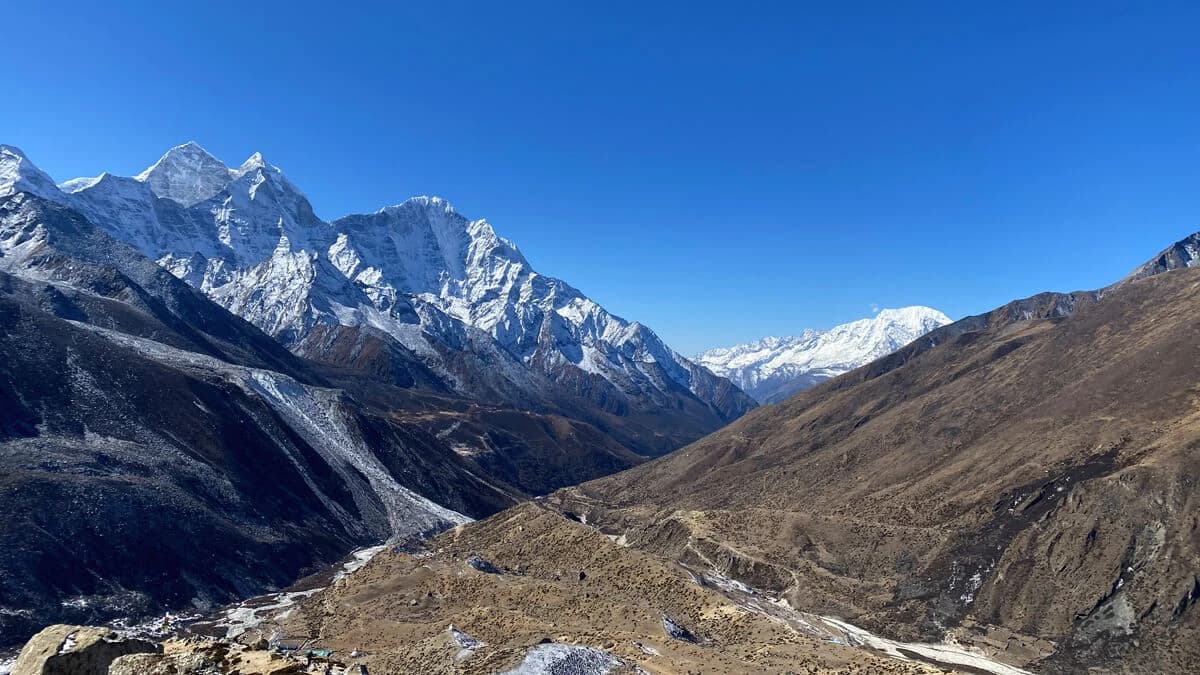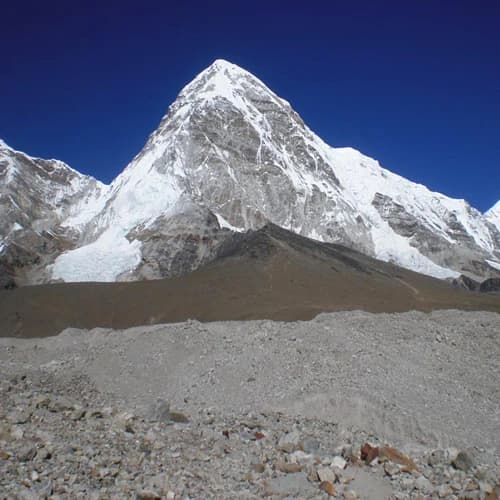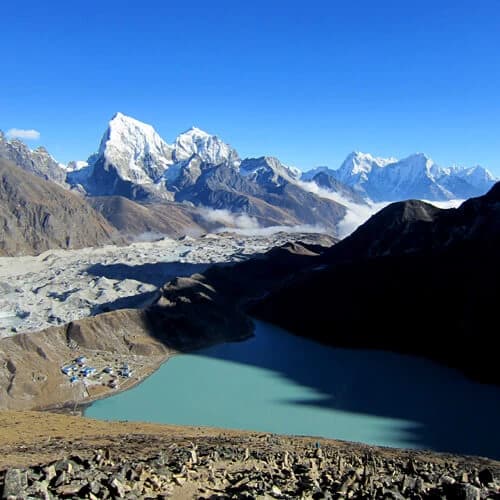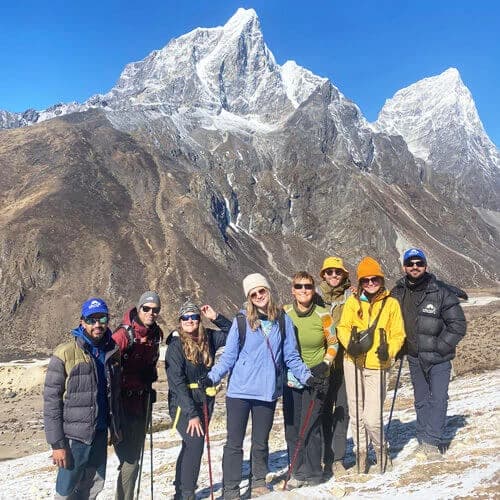The Everest Base Camp Trek is distinctly safe compared to summiting Mount Everest. This is outstandingly true in contrast to the risks involved and the technical abilities required to conquer the highest peak in the world. The Everest Base Camp Trek is one of the most famous expeditions and sought-after destinations by adventurers and trek enthusiasts. This fantastic trek is the perfect blend of natural and cultural immersion. The camp is located at 5,364 m and is the base of Mount Everest (8848 m). The exciting journey to the EBC begins from Lukla (2,860 m) and goes through Namche Bazar (3,440 m), Tengboche (3,867 m), Dingboche (4,410 m), and Gorakshep (5,164 m). Along the route, you can enjoy panoramic views of Mount Everest and immerse yourself in the rich culture of the Sherpas, interacting with the friendly locals and experiencing their unique traditions. During this trek, you will discover unique landscapes and the untouched natural beauty of Nepal. This article will explore the challenges and safety measures needed to overcome the obstacles and conquer the EBC trek.
Is Everest Base Camp Trekking Safe
Importance of Safety on Trek
Safety is the most essential aspect of any high-altitude trek in Nepal, and the Everest Base Camp Trek is no exception. The expedition poses some challenges due to its elevation gain and remote location. Safety measures are mandatory to avoid minor and significant injuries and ensure a satisfactory trip. According to recent statistics, 90 percent of the trekkers make it to the base camp among the 50,000 trekkers per year. So, we recommend that you follow the safety precautions first.
What are the Risk Factors for the Everest Base Camp Hike?
Everest Base Camp is a once-in-a-lifetime experience that will create memories for a lifetime. However, you must know some risk factors that might affect your trek experience. Staying well-informed and aware is crucial to mitigating these risks and ensuring a smooth journey.
Altitude Sickness
One of the most significant challenges for trekkers is altitude sickness. The condition happens when a body cannot adapt to the atmospheric changes and low oxygen levels in high-altitude regions. The common symptoms of altitude sickness are headache, nausea, vomiting, loss of appetite, fatigue, and dizziness. Additionally, dehydration, consumption of alcohol and narcotics, and lack of sleep can also trigger this condition.
Rapid Ascent
Due to diverse landscapes and uneven terrain, ascent and descent can be challenging and lead to injuries and accidents. The eagerness to reach the base camp may result in a speedy ascent during the trek. However, rushing or rapid ascent makes navigating and getting proper rest difficult, which could mentally and physically drain you. Look out for symptoms like excessive fatigue, shortness of breath, and dizziness, and slow down if you experience them.
Limited Oxygen
When you move to a higher altitude, the oxygen level gradually drops, and the air pressure decreases. This lack of oxygen causes the body to act abnormally, as it cannot adapt to the sudden change. You could feel difficulty breathing and staying consistent during the trek. Limited oxygen levels increase the chances of altitude sickness.
Overexertion
The Everest Base Camp Trek is exciting but also demands a lot from an individual. It involves days of travel with long walks through steep and uneven terrain, which can be stressful to the body. Fatigue and muscle pain can make moving further on the trek even more challenging and increase the chances of illness and some minor accidents.
Extreme Weather
Weather conditions can be unpredictable during the Everest Base Camp trek. Different seasons have different weather patterns, which creates uncertainties regarding the trek. The Everest region experiences freezing temperatures at higher altitudes, and trekkers must also deal with the changing weather conditions along the trail.
Dehydration
Dehydration is another primary risk factor. Trekkers must keep their bodies hydrated to hike at high altitudes with low air pressure and limited oxygen levels. Lack of water may lead to fatigue and several illnesses.
Lack of Medical Facilities
Due to remote conditions, the Himalayan region of Nepal lacks advanced medical assistance. Trekking is directly related to physical risk, so a lack of proper health can be challenging.
Unstable Communication
The weather might affect the Everest Base Camp's communication facility. Such unstable connections may put trekkers at risk. You can access Wi-Fi and phone services during the trek, but there are no such services at the camp. Regardless, our team members will be carrying a satellite phone in case of emergencies.
Transportation
Transportation facilities are complicated due to the remoteness of the destination and the uneven landscape. Some flights to and from Lukla can be delayed or canceled due to extreme weather conditions, which can directly affect the trekkers’ itinerary.
Sunburn and UV Radiation
The sun's intensity is more vigorous at high altitudes, increasing the chance of sunburn and skin damage. Air pressure decreases, and the atmosphere changes with the elevation. Further, trekking on snow can cause UV rays to reflect, which may lead to skin irritations.
Environmental Hazards
Various environmental factors hamper the trekkers during the Everest Base Camp Trek. The expedition involves challenging terrain and unpredictable weather conditions. Trekkers can encounter freezing temperatures, snowstorms, high winds, and threatening wildlife. Moreover, travelers must know about potential wildlife encounters and how to handle them.
Isolation
Everest Base Camp is located at the foot of Mount Everest in the Khumbu region. During the trek, you can be free from your daily routine and relax, but the limited means of communication and reaching civilization can be challenging. There can be some situations where trekkers get lost, and finding the way can be difficult.
How to Minimize the Risk During the Everest Base Camp Trekking?
You might experience certain risk factors that might affect your trek experience. However, precaution and awareness will help you tackle the challenges. Here are various ways to mitigate risks during the EBC trek:
Proper Acclimatization
Acclimatization is crucial to reduce altitude sickness and other issues associated with trekking to high-altitude regions. The process helps your body adapt to the environment, temperature, and air pressure. You must follow the listed acclimatization schedule per the itinerary to help your body adjust to the changes. For example, spending a rest day at Namche Bazaar (3,440 m) to acclimatize will assist your body in rejuvenating and effectively adapting to the increasing elevation. Outfitter Nepal prioritizes acclimatization, with dedicated days in our itinerary and experienced guides to help you with the process.
Altitude Medication
Apart from taking rest days, packing prescribed medication is also an effective way to deal with the risks involved with altitude sickness. Acetazolamide is a popular medicine among travelers, and it is used to prevent altitude sickness. These pills stimulate ventilation and help you adjust to higher altitudes faster. Take it a day before ascent and continue with approximately 125 mg every 12 hours. Watch for side effects like rashes, fever, and difficulty breathing, and consult a professional if they occur. Individuals with issues related to kidney, liver, or lung diseases, as well as pregnant or breastfeeding women, should inform professionals before taking the medication.
Physical Preparation
Training your body before embarking on the EBC trek is essential. Incorporate exercises that build stamina and endurance to prevent physical discomfort and avoid accidents during the trek. Follow a basic training plan, such as hiking, running, and strength training, leading up to the trek. Aim to start your training at least three months before the start of your remarkable journey.
Pack Smart
Efficient packing is crucial for a successful trek. Pack light and prioritize essentials, which will assist you during the expedition. A heavy backpack can tire you quickly, making it challenging to tackle the terrain. Moreover, we recommend you invest in high-quality trekking gear, including comfortable boots, a down jacket, thermal wear, a headlamp, and a good-quality backpack and sleeping bag.
Know Your Limits
The EBC trek is physically demanding, so one must take adequate rest and ascend gradually. Understanding your limits helps mitigate the risk of accidents, allowing you to pace yourself wisely to avoid fatigue and altitude sickness. Regularly assess your physical and mental limits to prevent overexertion. It's essential to listen to your body and rest when needed.
Choose the Right Season
Selecting the right season is crucial for a safe and enjoyable trek. The ideal times to trek to Everest Base Camp are spring (March to May) and autumn (September to November). These seasons offer stable weather conditions, clear skies, and moderate temperatures, making for a relaxed experience. So, opting for the right season minimizes difficulties and maximizes your chances of a quality trip.
Carry a First-Aid Kit
Bringing a personal first-aid kit, including prescribed medications, is essential to ensuring your well-being. Guides from reputable companies like Outfitter Nepal are trained in first aid and carry well-equipped kits, providing prompt care when needed. Quick treatment of injuries helps avoid complications and infections. Items like bandages, antiseptic wipes, painkillers, and altitude sickness medication are essential.
Stay Hydrated and Eat Well
The EBC trek is demanding, so prioritizing health and fitness is crucial. Nutritious Nepali meals at rest stops will provide energy while staying hydrated and reduce the risk of dehydration and altitude sickness. So, consume carbohydrate—and protein-rich meals to maintain your energy levels. Besides, avoid alcohol, caffeine, and heavy meals before sleep. Drink plenty of water and monitor your urine color to ensure proper hydration. You must aim for at least 3-4 liters of water per day.
Stay Informed
Maintaining awareness and staying connected are fundamental principles before and during the trek. Understanding the trail, weather conditions, healthcare, local culture, and facilities helps trekkers plan accordingly. Having comprehensive information enables preventive measures and ensures a smooth journey.
Travel with a Reputable Company
Selecting a reputable company is essential for a satisfactory trekking experience. Conduct thorough research and take feedback seriously. A respected and reputable company like Outfitter Nepal provides better guides, prioritizes safety, and ensures a fulfilling experience. Follow the criteria for choosing a reputable travel and tour company to ensure a safe and enjoyable trek. Check reviews, ask for recommendations, and ensure they have experienced guides.
Additional Tips
- Always trek with a group or guide to ensure safety.
- Use reliable sources for trail and weather information. Websites like Mountain Forecast and apps like Windy are helpful.
- Use high-SPF sunscreen (SPF 50 or higher) and protective clothing to avoid sunburn. Sunglasses with UV protection are also essential.
- If flights are canceled, helicopter services are available as an alternative to flights for urgent travel needs.
- Carrying a satellite phone can be helpful in emergencies. You can also rent portable Wi-Fi devices for better connectivity. Have a list of emergency contacts and services available along the route.
- Supplemental oxygen or portable hyperbaric chambers are available at some points along the trek, and portable oxygen cylinders can also be used.
Final Thoughts
The EBC trek is an extraordinary adventure that offers remarkable views and an opportunity to experience the rich Sherpa culture. While it presents several risks, thorough preparation, and awareness can ensure a safe and enjoyable trek. Prioritize safety, follow the necessary precautions, and respect the mountain environment to make the most of this incredible journey. Listening to experiences from experts can also provide valuable insights and make your trip even more rewarding.
Some Most Popular Treks
- Everest Base Camp Trek - 14 Days
- 12 Days Everest Base Camp Trek
- Everest Base Camp Luxury - 14 Days
- Everest Cho La Pass - 17 Days
- Everest High Pass 16 - Days
- Annapurna Base Camp - 13 Days
- Ghorepani Poon Hill - 7 Days
- Annapurna Circuit - 17 Days
- 12 Days Annapurna Circuit Trek
- Manaslu Circuit - 14 Days
- Manaslu Trek 12 Days
- Everest Base Camp with Island Peak - 16 Days
- Everest Luxury Trek with Helicopter Return
- Langtang Valley - 10 Days





